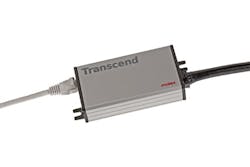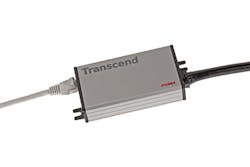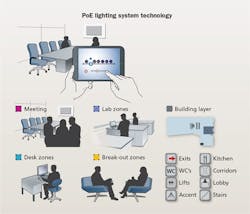Power over Ethernet as IoT infrastructure for commercial spaces
By Giovanni Frezza, Molex
One of the most promising technologies allowing Internet Protocol (IP) convergence for building automation networks, Power over Ethernet (PoE) distributed networks deliver electrical power and transmit communication signals over standard low-voltage category cabling to various endpoints - including LED lighting, HVAC controls, cameras and other locally networked devices. PoE distributed networks offer high availability for power, guarantee uninterrupted service and lower operating expenses by providing network resiliency at a lower cost by consolidating backup power.
Smart lighting sets the stage
The need for “smart” lighting in commercial buildings set the stage for PoE distributed networks. LEDs require low-voltage DC power in contrast with older lighting sources, which use AC power. Distribution of power and data on low-voltage cabling is possible using the same category infrastructure deployed by the IT industry. Delivering significantly improved light quality, with smoother intensity and dimming functions, and dynamically adjustable color temperature, LEDs are versatile, efficient, secure and able to support available wattages in PoE networks.
PoE LED lighting requires the low-voltage power distribution and data communication backbone for control. Each PoE node receives a unique IP address, allowing integration of LED fixtures, sensors and other devices with other building automation systems. Powered with a simple RJ45 connector, lights, sensors and other devices become intelligent and are faster to deploy by eliminating the need for an electrician to line voltage infrastructure, rework wiring and install power outlets at every endpoint.
By adapting to mood, task and ambient lighting, PoE LED lighting systems can be used to customize the user experience using direct, indirect, ambient and decorative schemes in a dynamic and purposeful control. LED luminaires with bio-adaptive functionality can mimic natural daylight by gradually changing from cool-temperature, high-intensity in the morning to a warmer, less-intensive light later in the day. Subtle changes in lighting intensity provide a more natural work environment that fosters higher productivity, while optimizing energy savings through sensor feedback.
PoE distributed networks also support trends in scalable densification, with more efficient and functional workspace layouts than traditional cubicles or offices. Networked light switches, WiFi and device charging stations, video, teleconferencing and presentation equipment for sharing laptop and mobile device content can accommodate staff collaboration. Control over PoE allows rapid changes in device parameter settings and zone programming simply be reassigning devices and sensors depending on space utilization needs.
Sensors located throughout a commercial or office space, often embedded in LED lighting fixtures, can collect and feed data to a central host server to report and measure air quality, temperature, occupancy and real-time energy consumption for improved operational control and efficiency. Aggregate data collected over time translates into business insights, informing space utilization and flow patterns, dynamic conditions within specified areas, and how different spaces, floor, or buildings compare in terms of utilization, energy usage and productivity.
Streamlined construction and retrofit
A PoE distributed network infrastructure can add significant value for building developers, owners and occupants. By eliminating the need for a dual infrastructure - one to distribute power and another to provide communication, data and control on low-voltage cables, new construction and deep retrofits are simpler and faster than traditional AC/DC lighting and building automation systems. Although most installed control systems today are based on proprietary solutions, leading technology suppliers and the commercial building industry are trending toward use of open standards to simplify the installation, configuration and commissioning of new PoE platforms that allow power and data on the same low-voltage cable infrastructure.
IEEE 802.3 standards define PoE networks, specifying the physical and data link layers for wired Ethernet networks, power sourcing equipment and devices using two-pair or four-pair connections to transmit power. The original PoE standard (IEEE 802.3af) based on 15.4W per switch port of power has increased to 30W in PoE Plus (IEEE 802.3at) using a two-pair power transfer format. Newer standards use a four-pair power transfer format designed to support 60W (UPOE) and more than 95W (POH) per switch port. UPOE technology uses all four twisted pairs.
A PoE gateway physically connects and powers luminaires, sensor nodes, wall dimmers, and other local devices to the control manager. A growing variety of sensors and devices can be powered by a PoE gateway and deployed as modules or integrated with lighting fixtures. In some applications or cases, PoE can be bridged to wireless technology. For building automation and digital lighting a sub-GHz wireless technology is well-suited. Wireless devices such as wall switches and dimmers can use energy harvesting technology to communicate wirelessly with the PoE gateway, without even requiring batteries or other sources of local power.
After power negotiation and establishing a secure connection between the gateway (powered device) and a network switch (power source equipment), a node can distribute power and data to the local devices. When devices are powered and connected they can be controlled and can provide granular data for reporting and advanced data collection for aggregate building analytics.
For a purposeful and holistic control of zones, spaces, floors and the entire building, lighting is based on software controls. Software tools should provide support during the complete lifecycle of a networked lighting control system, from design and installation to live operation and building maintenance. The right design tools can enable configuration of a building’s lighting system prior to on-site installation. Interactive floorplan views, predesigned light-scenes and a drag-and-drop interface can allow for fast layout of sensors, building lighting policies and user zones. Advanced planning and field tools simplify commissioning and on-site testing with some systems using smart devices for convenience. From an operational standpoint, facility managers depend on software control for a bird’s eye view of an entire building, with live monitoring and status updates, error reporting and sensor feedback, including system troubleshooting with immediate access and control of any zone.
Category cabling: Industry gold standard
Technologies used in PoE networks are well-defined by the industry in the IEEE 802.3 standards, which specify the physical and data link layers for wired Ethernet, power sourcing equipment and devices using two-pair or four-pair connections to transmit power and create a link to exchange data. A PoE distributed network operates across low-voltage category cable using the same proven infrastructure that the IT industry has deployed for over a decade.
Category 5e copper twisted-pair cabling was specifically designed to support Gigabit Ethernet (GbE). The four pairs in the cable support bandwidth of 100 MHz to transmit 1000 Mbits/sec. Category 6 cabling supports the 1000Base-TX protocol enabling GbE, supporting 200 MHz and adding a little headroom of 50 MHz. While Category 5e cable is the minimum that can be specified for a PoE network system, Category 6 23-gauge cable is recommended as best practice in new installation.
Rapid growth in the use of wireless devices is driving up demand for wireless access points in commercial spaces, which is a consideration when specifying category cabling for a PoE distributed network. Medium-speed Ethernet protocols - 2.5GBase-T and 5GBase-T - support the use of legacy Category 5e and popular Category 6, which offers the ability to minimally double speed, or multiply up to five times, allowing the use of high-end wireless access points and supporting new generations of switches. Category 6 supports both standards, whereas Category 5e is dedicated for 2.5G, although it can support 5G but with limitations.
PoE lighting over category cable infrastructure is mainly driven by cost and power distribution performance more than speed and data bandwidth. For this reason, lighting control and other building automation systems do not require shielded, high-performance category cables.
Power losses over a low-voltage cable infrastructure can be reduced by using a heavier-gauge cable and a proper horizontal cable infrastructure design. In general, the recommended maximum cable bundle size is no more than 98 cables to keep heat within an acceptable range. The power must be reduced if temperatures exceed prespecified limits. The longer the distance where cables are bundled, the more difficult it is to achieve requirement of the new protocols.
Shielded Category 6A cabling is not necessary for PoE lighting and building automation systems as Category 6A and above are often used in high-end wireless access points exceeding 1G. While more costly than Category 5e cable, Category 6A can support 10G up to 100 meters without limitations, with bandwidth frequencies up to 500 MHz, and is compatible with PoE and PoE Plus standards.
Creating value in commercial space
A well-implemented PoE distributed network can deliver substantial value in commercial buildings and enterprises, including the following.
- Well established and scalable Ethernet standards
- DC power, ideal for LED and sensor applications
- Eliminates dual-layer infrastructure for power and signal
- Power and signal over single-layer infrastructure uses standard category cable
- Easy-to-install endpoints using low-voltage standard RJ45 connections
- Advanced control of tunable LED luminaires and dynamic/bio-adaptive controls
- High availability, uninterrupted power service, and network resiliency
In a recent report, Navigant predicts the global market for PoE lighting to expand more than tenfold between 2016 and 2025. They cite energy and cost savings as key factors that will drive market growth. By eliminating the need for power conversion, PoE provides a clear path for higher energy efficiency and innovative lighting technologies with embedded sensors for building automation and analytics. (Source: Navigant PoE Market Research Report)
The tools exist to efficiently scale a PoE distributed network lighting and automation system to almost any space size or configuration. Large-scale distributed network pilots and full-scale deployments are becoming increasingly common. Optimizing the low-voltage cable infrastructure to deploy power and data in more convenient ways requires hybrid technologies, including PoE and distributed power conversion, and strategies to limit power losses.
Giovanni Frezza is group product manager with Molex (www.molex.com).



